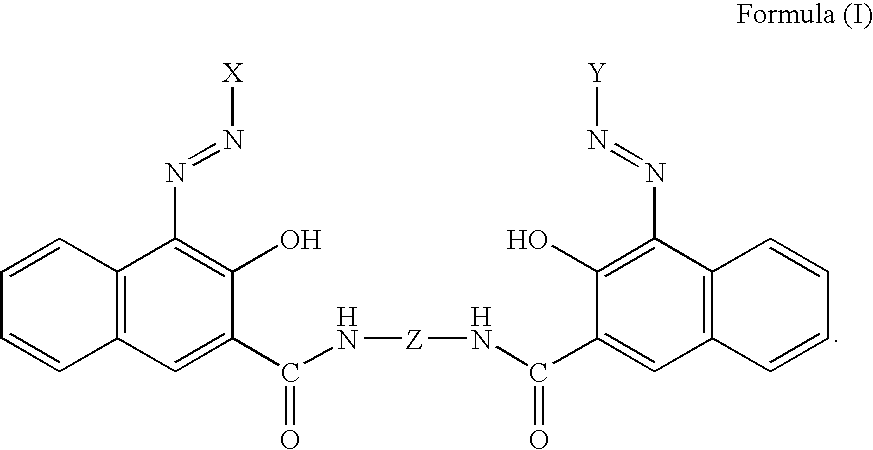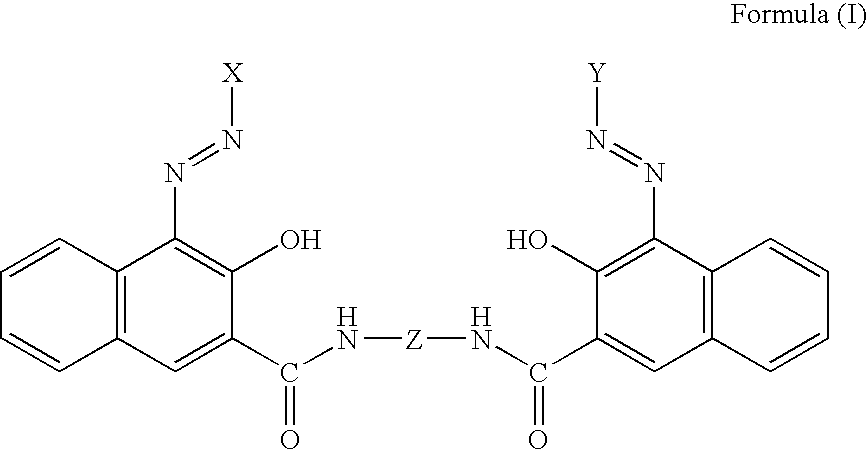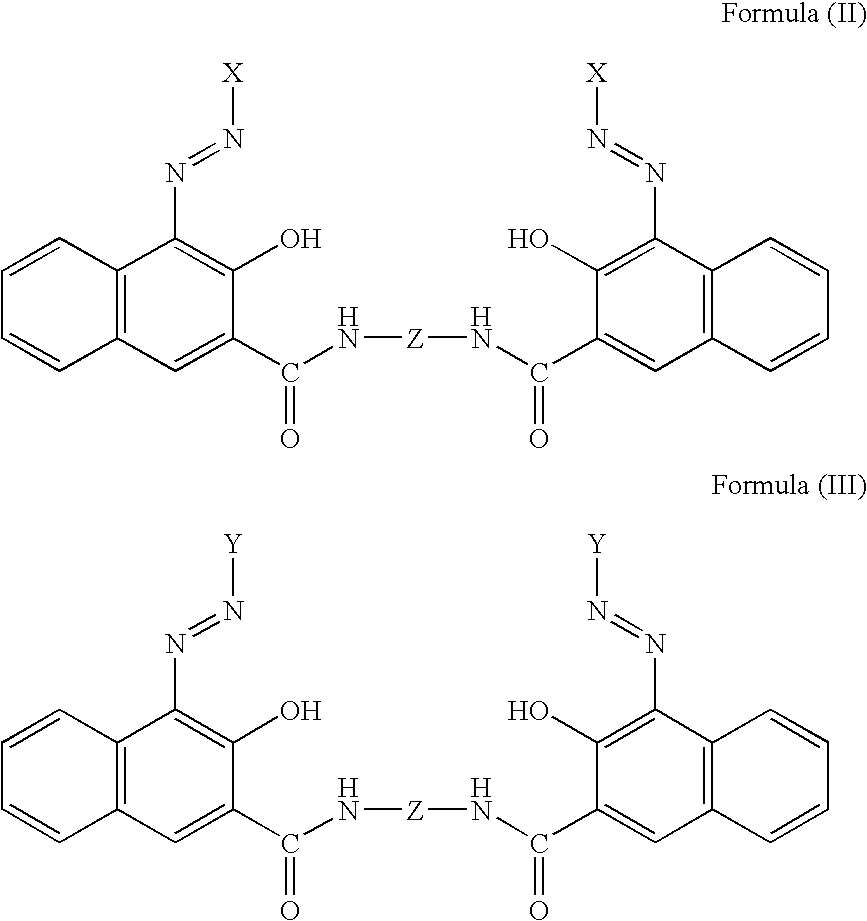Pigment dispersants and their use
a pigment dispersant and pigment technology, applied in the field of pigment dispersants, can solve the problems of red pigment being dissatisfactory as a pigment, red pigment lacks transparency, and insufficient transmission as pixels for cf, and achieves good dispersion stability and good developability
- Summary
- Abstract
- Description
- Claims
- Application Information
AI Technical Summary
Benefits of technology
Problems solved by technology
Method used
Image
Examples
synthesis example 1
[0047]In a manner known per se in the art, 3-hydroxy-2-naphthoic acid (60 parts) was converted into an acid chloride with thionyl chloride (40 parts) in nitrobenzene (400 parts), 2,5-dichloro-1,4-phenylenediamine (25 parts) was added, and the resulting mixture was heated at 130 to 135° C. for 5 hours. Subsequent to cooling, methanol (200 parts) was added. The resulting precipitate was collected by filtration, washed with methanol and then with water, and dried to obtain a reactant (60 parts).
[0048]To an aliquot (10 parts) (0.02 mole) of the reactant, methanol (100 parts), sodium hydroxide (3 parts) and sodium acetate trihydrate (11 parts) were added to prepare a grounder solution. Sulfanilic acid (3.5 parts) (0.02 mole) was diazotized by a method known per se in the art, and the diazotized reactant was then caused to couple to the grounder solution. One hour later, 2-chloro-5-trifluoromethylaniline (4.3 parts) (0.022 mole) was diazotized by a method known per se in the art, and the ...
synthesis example 2
[0052]In a similar manner as in Synthesis Example 1 except for the use of 3,3′-dichlorobenzidine (35 parts) in place of 2,5-dichloro-1,4-phenylenediamine (25 parts), there was obtained the pigment dispersant (B) (15 parts) comprising as a main component the compound represented by the below-described formula, which dispersant (B) was determined to contain on average 1 sulfonic group introduced per molecule from the results of an elemental analysis for sulfur.
[0053]
[0054]The above reactant had a possibility to contain the byproducts described by the below formulae, but the removal of the byproducts from the reactant was not needed.
[0055]
synthesis example 3
[0056]In a manner known per se in the art, 3-hydroxy-2-naphthoic acid (60 parts) was converted into an acid chloride with thionyl chloride (40 parts) in nitrobenzene (400 parts), 1,4-phenylenediamine (17 parts) was added, and the resulting mixture was heated at 130 to 135° C. for 5 hours. Subsequent to cooling, methanol (200 parts) was added. The resulting precipitate was collected by filtration, washed with methanol and then with water, and dried to obtain a reactant (57 parts). To an aliquot (10 parts) (0.022 mole) of the reactant, methanol (100 parts), sodium hydroxide (3 parts) and sodium acetate trihydrate (11 parts) were added to prepare a grounder solution. Sulfanilic acid (3.9 parts) (0.022 mole) was diazotized by a method known per se in the art; and the diazotized reactant was then caused to couple to the grounder solution. One hour later, 2,5-dichloroaniline (4 parts) (0.025 mole) was diazotized by a method known per se in the art, and the diazotized reactant was also cau...
PUM
| Property | Measurement | Unit |
|---|---|---|
| viscosity | aaaaa | aaaaa |
| temperature | aaaaa | aaaaa |
| temperature | aaaaa | aaaaa |
Abstract
Description
Claims
Application Information
 Login to View More
Login to View More - R&D
- Intellectual Property
- Life Sciences
- Materials
- Tech Scout
- Unparalleled Data Quality
- Higher Quality Content
- 60% Fewer Hallucinations
Browse by: Latest US Patents, China's latest patents, Technical Efficacy Thesaurus, Application Domain, Technology Topic, Popular Technical Reports.
© 2025 PatSnap. All rights reserved.Legal|Privacy policy|Modern Slavery Act Transparency Statement|Sitemap|About US| Contact US: help@patsnap.com



